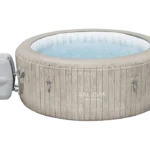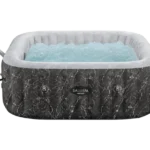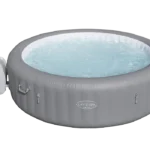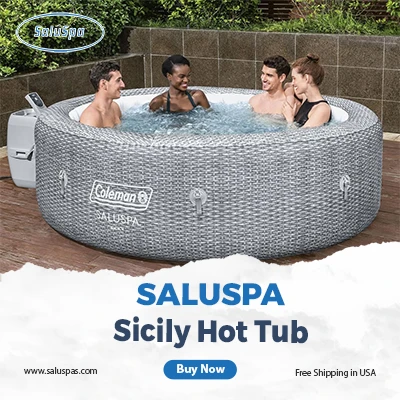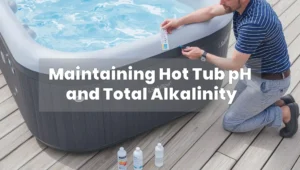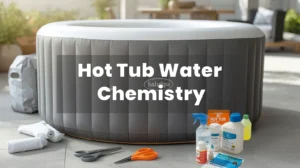Proper water chemistry stands as the foundation of hot tub maintenance, protecting both your equipment investment and your health. Among all chemical parameters, pH and total alkalinity form the backbone of balanced water chemistry. Understanding how these two factors interact determines whether your spa provides a safe, comfortable soaking experience or becomes a source of equipment damage and skin irritation.
What Is pH in a Hot Tub and Why It Matters?
pH measures hydrogen ions in hot tub water. It identifies if the water is acidic, neutral, or alkaline. The pH scale spans from 0 to 14, with 7 being neutral. Spas benefit from a pH range of 7.2 to 7.8. Hot tub water, like tears and mucous membranes, is somewhat alkaline.
Since human skin has a pH of 5.5, this small amount of alkalinity is critical. When you soak in water with the right pH, you get less skin shock. When pH levels fall short of ideal, problems quickly increase. Acidic water causes skin irritation and rusts hot tub components. Overly basic water harms the skin and diminishes the efficacy of cleansers.
Chemical equilibrium affects more than just comfort. The pH of your water affects how effectively chlorine and bromine clean it. Chlorine operates best at a pH of 7.5. Chlorine is half as efficient at pH 8.0, therefore additional chemicals are required to keep water quality poor. Expert spa owners are attracted by pH levels because of the relationship between pH and sanitiser efficacy.
| Parameter | Value |
|---|---|
| pH Scale Minimum | 0 |
| Neutral pH | 7 |
| pH Scale Maximum | 14 |
| Ideal Hot Tub pH Range | 7.2 – 7.8 |
| Human Skin pH | 5.5 |
| Optimal Chlorine pH | 7.5 |
| Chlorine Efficiency at pH 8.0 | 50% |
Total Alkalinity and Its Role in Water Balance
Total alkalinity (TA) acts as pH’s stabilising partner in water chemistry. pH indicates current acidity or alkalinity, while total alkalinity shows your water’s ability to resist pH changes. Consider alkalinity a buffer system that absorbs chemical changes, preventing significant pH fluctuations.
Maintain a total alkalinity level of 80-120 ppm in your hot tub. This range offers enough buffering capacity to maintain stable pH despite chemical additions, bather load, and environmental influences. Alkalinity mainly includes bicarbonates, carbonates, and hydroxides in water—substances that neutralise acids before they significantly change pH.
Alkalinity and pH influence each other in a bidirectional manner. When alkalinity is in the right range, pH stays stable and is easier to adjust. On the other hand, levels below 80 ppm make water corrosive and acidic, which can stain or damage hot tub surfaces. High alkalinity over 150 ppm leads to the opposite issue—pH becomes difficult to adjust, increasing the likelihood of calcium scaling.
| Parameter | Value | Unit |
|---|---|---|
| Recommended Total Alkalinity Range | 80 – 120 | ppm |
| Low Alkalinity Threshold | 80 | ppm |
| High Alkalinity Threshold | 150 | ppm |
Ideal pH and Alkalinity Levels for Spas
Precision is crucial for setting target ranges in hot tub chemistry. Total alkalinity in hot tubs should be between 80 and 120 parts per million, while pH is best maintained around 7.4 to 7.6. These ranges are not arbitrary; they reflect decades of research into water chemistry, equipment compatibility, and human comfort.
Adjusting alkalinity first before tackling pH leads to the most stable water chemistry. Once alkalinity establishes buffering capacity, pH adjustments are easier and last longer. Spa owners often err by pursuing pH adjustments before stabilising alkalinity, leading to a frustrating cycle of constant readjustments.
Temperature significantly impacts these parameters. Hot water speeds up chemical reactions and accelerates pH changes. Hot tubs have higher temperatures, causing chemistry to change more quickly than in swimming pools, necessitating more frequent monitoring and adjustments. This explains why weekly testing is enough for pools, while hot tubs require testing 2-3 times a week during regular use.
How to Test Hot Tub pH and Alkalinity?
Accurate testing is the first step towards maintaining proper water chemistry. The three main testing processes vary in terms of ease, accuracy, and cost.
Test Strips: The fastest method is to use test strips. Dip a strip in water for 15 seconds, then compare the colours to the chart. According to industry and water quality experts, test strips are just as accurate as liquid solutions, but less exact. Test strips are useful for regular monitoring in between deeper tests.
Liquid Test Kit: Titration enhances the Liquid Test Kit’s accuracy. These are the most accurate, and involve adding titrant drops to a water sample until a colour change appears. Chemical concentration is expressed by the number of drops needed. Liquid kits provide precise measurements for important adjustments, but they take longer than strips.
Digital Testers: Digital testers use cutting-edge electronics. Compared to traditional test strips, sensor-based digital water testers provide more reliable results and remove human error. Although more expensive, computerised tests reduce color-matching uncertainty.
Our Recommendation: Complete Spa Maintenance Kit
Correct sample collection ensures accuracy regardless of testing method. Draw elbow-deep water from the spa centre, away from the jets and return lines. Chemical concentrations fluctuate after spa water leaves, so test immediately. The most reliable baseline results are obtained in the morning, before daily use.
Common Imbalances and Their Causes
High pH in Hot Tub: Causes & Effects
There are several common causes of elevated pH. Hard water has a higher pH because of the dissolved minerals. Extra sanitiser, particularly calcium hypochlorite shock, increases pH. Alkaline chemicals included in body oils, cosmetics, and perspiration raise pH with time.
When the pH exceeds 7.8, a variety of difficulties develop. Sanitiser efficiency decreases, allowing germs and algae to colonise your spa. As minerals precipitate, water gets murky. Scale accumulates quickly on surfaces, pipes, and heating elements, reducing equipment performance and lifespan. Soaking can cause dryness and irritation to the skin and eyes.
Low pH in Hot Tub: Causes & Effects
Low pH occurs when acidic things accumulate faster than your alkaline buffer can neutralize them. Unsecured covers dilute spa chemistry with rainwater (pH = 5.6). Using a lot of sanitizer decreases the pH. Acidic compounds released by sanitisers such as trichlor chlorine tablets reduce pH over time.
Acidic water harms everything. Metal components rust, releasing iron and copper, which discolor surfaces and turn water green or brown. Vinyl covers wear down rapidly. Brittle seals and gaskets fail early. The corrosive atmosphere burns and irritates the skin and eyes, pushing visitors away from the spa.
High Alkalinity in Hot Tub: Causes & Dangers
Too much sodium bicarbonate (baking soda) while raising the pH usually results in high alkalinity. Some water is naturally high in bicarbonate. Alkalinity levels more than 150 ppm make pH stabilization problematic, resulting in intractable water chemistry.
High alkalinity not only stabilizes pH but also induces calcium scaling. Cloudy, chalky water. As scale deposits accumulate, surfaces may feel rough. Scaling heating components diminishes efficiency, increasing energy costs and risking equipment failure.
Low Alkalinity in Hot Tub: What It Means
Low alkalinity reduces water’s buffering ability, making pH sensitive to even minor chemical or environmental changes. Despite the changes, the water becomes unstable and fluctuates in pH. This instability strains equipment and renders safe, pleasant water nearly impossible.
When the alkalinity of the water is too low, it encourages corrosion without any chemicals to neutralize natural acids. Equipment falls down quickly, necessitating the replacement of years-old parts. Fluctuating pH and caustic water can injure both equipment and bathers.
How to Adjust and Balance pH and Alkalinity?
How to Raise pH Levels in Hot Tubs?
Soda ash (sodium carbonate) is the most effective at raising pH while remaining alkaline. Calculate the required amount based on spa volume and pH. Slowly add soda ash, allowing 30 minutes between additions to circulate. Repeat before adding more to prevent overshooting.
Aeration elevates pH naturally and without the use of chemicals. Running jets without a cover emits CO2, gradually rising pH. This approach is ideal for small changes and gives excellent control, although it takes longer than chemical addition.
How to Increase Alkalinity Safely?
You can boost the alkalinity of your hot tub by using baking soda or an alkalinity increaser. Pure baking soda is less expensive than most commercial alkalinity increasers, which are primarily sodium bicarbonate.
With the jets running, gradually add alkalinity increasers to the spa surface. Avoid extremes, and aim for 80-120 ppm. Retest following several hours of dissolution and dispersion. Raising alkalinity raises pH, therefore drop it after stabilization.
How to Decrease Alkalinity Without Lowering pH?
Aeration is required to reduce alkalinity while keeping pH stable. To reduce pH and alkalinity, use small doses of sodium bisulfate or muriatic acid or any alkalinity decreaser. After several hours of acid work, vigorously aerate using jets that are not covered. Aeration increases pH but not alkalinity, separating the two.
This requires multiple iterations. Test frequently, make careful tweaks, and allow additions to stabilize. Rapid alkalinity reduction might result in pH crashes and overcorrection, necessitating additional rebalancing.
Maintaining Stable Water Chemistry (Long-Term Tips)
In terms of water chemistry management, prevention is preferable to correction. Maintain a testing schedule, preferably before each use for heavily used spas, or three times per week. Keep maintenance journal readings to identify trends before they become problems. Past data indicates when adjustments are required.
Shower before entering your spa to remove any oils, lotions, or cosmetics that may interfere with the chemistry. Organic compounds disrupt water balance, consume sanitizer, and alter pH. Showering for a few minutes can save you hours of readjustment.
Look at This Product: Hot Tub Cleanse Gel
Maintain water levels to get precise chemical concentrations. Evaporation concentrates alkalinity-causing minerals and dissolved substances. Diluting these compounds with fresh water results in temporary imbalances that must be corrected. To avoid water level decreases, top off with small amounts on a regular basis.
Replace 25-30% of the spa water every three months, or more frequently if it is heavily used. Total dissolved solids accumulate despite your best chemical management, overwhelming your balance. Partial water changes, which restore chemistry, delay full drainage.
FAQs
How often should I test hot tub water?
Test pH and alkalinity 2-3 times weekly during regular use, daily during periods of heavy use or after adding chemicals. More frequent testing prevents problems rather than forcing you to correct them.
Can I use pool chemicals in my hot tub?
Many pool chemicals work in spas, but verify compatibility first. Avoid trichlor tablets in spas—the acidic nature causes persistent pH problems in small water volumes. Stick with dichlor granules or bromine systems designed for spa use.
What causes cloudy water despite balanced pH?
Total dissolved solids, inadequate filtration, or sanitizer depletion commonly cause cloudiness even with proper pH. Check sanitizer levels first, ensure your filter receives regular cleaning, and consider a partial water change if TDS exceeds 1,500 ppm above your fill water baseline.
Is baking soda the same as alkalinity increaser?
Yes, sodium bicarbonate (baking soda) functions identically to most commercial alkalinity increasers. Purchase pure baking soda in bulk for significant savings compared to spa-specific products.
Final Thoughts
Successful hot tub ownership necessitates pH and alkalinity management. These factors influence everything from sanitizer efficacy to equipment longevity in water chemistry. Understanding and maintaining balance lowers chemical costs, eliminates equipment problems, and makes soaking enjoyable.
Water chemistry goes beyond pH and alkalinity. Your maintenance plan includes sanitizing, calcium hardness, and shock treatments. All parameters interact, resulting in a sophisticated system that demands care but rewards it with crystal-clear, perfectly balanced water that safeguards your health and investment.
